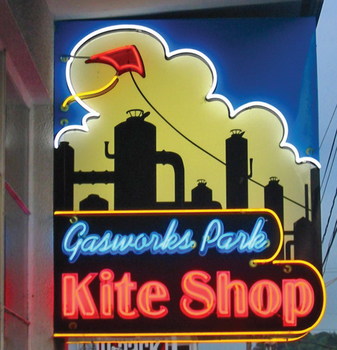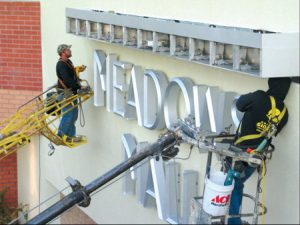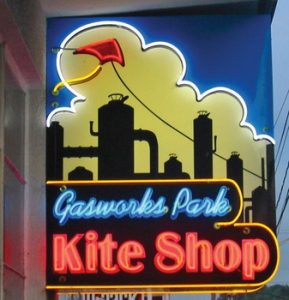Business Management
Minding the Store
Signshop operation incurs many potential hurdles.
Published
17 years agoon

A signmaker could be described as one-third artist, one-third crafts-person and one-third entrepreneur. Of course, every industry professional’s abilities and inclinations vary, but he or she must exercise each aspect to develop a successful business.
ST Publisher/Editor Wade Swormstedt estimates approximately 40,000 U.S. signshops (which range from the solo weekend warrior to the 100-employee, full-service megashop), and each enterprise uniquely develops its path to profit.
Yet, financial realities impact purchasing a major piece of shop equipment, budgeting for a shop expansion to meet production requirements or growing a salesforce to cover more territory. Here, several signshop owners and industry experts offer tips about how to prepare for and, hopefully, thrive during significant transitions.
Major-equipment investment
Streamlined production and widespread competition have long helped advancing technology progress from “bleeding edge” to “leading edge” to “easily accessible” (remember $200 calculators and $500 microwaves a generation ago), and signshop equipment has been no exception. Inkjet printers, routers, plotters and other staple equipment still constitute major purchases that may stretch beyond a signmaker’s available cash.
AdvertisementWhen cash isn’t feasible, an equipment buyer has two options: financing a purchase, which a shop could pursue through banking institutions, or a lease, which could be arranged through a qualified leasing agency.
Two kinds of leases exist – a closed-end lease, for which the lessee pays for the equipment’s use during the lease term, or an open-ended lease, which costs buyers more per month but allows them to purchase the equipment for a nominal amount – often just $1 – at the lease’s end.
Established by Congress in 1953, the U.S. Small Business Administration (SBA) seeks to “aid, counsel, assist and protect” American small businesses. John Scott, SBA’s district director for Nevada, said the organization offers two loan programs that could benefit signshops and, ultimately, their customers.
The 7(a) loan program provides federal loan guarantees with hundreds of participating banks. The bank assumes reduced risk, and the small business receives multi-year, fixed-term financing at variable rates with no prepayment penalties.
Also, the SBA offers the 504 loan program, which creates a “50-40-10,” debenture-based lending structure through a nationwide network of certified development companies that work with the SBA to provide long-term, fixed-rate, capital-asset funding up to $3 million. The buyer produces a 10% down payment; the SBA guarantees 40% of the loan, and the bank administers the remainder and takes the first lien on the equipment if the borrower defaults. Because the SBA guarantees the debenture, the borrower can obtain a lower APR than standard commercial loans. Scott estimates the SBA adminis¬tered approximately $5 billion worth of 504 loans in 2005.
Bill Clark, general manager of Equipment Leasing Options (Cincinnati), recommends leases, because they require little startup capital and a one-page application for a decision within 24 hours that determines the applicant’s credit qualification.
Advertisement“The only initial cash outlay required is the equivalent of the first and last months’ payments, which is considerably less than the 10 to 20% down payment required to finance a purchase,” Clark said. “Also, leases don’t appear on a personal credit report like a car loan or mortgage. Leases keep assets off your balance sheet and help you operate a ‘leaner’ company while profiting from the new equipment.”
Amy Ugstad, marketing manager for Geneva Capital (Alexandria, MN), which specializes in financing graphic-arts equipment purchases, said the customer benefits from the 24- or 36-month lease terms because the industry’s technology rapidly changes, and shops want to avoid obsolescence. However, lessees can also choose longer terms up to 60 months.
Leases offer other fiscal advantages– lessees can opt for a tax lease, where payments can be deducted on tax returns for the lease’s duration, or they can take advantage of an IRS Section 179 provision, which allows a one-time deduction of up to $112,000 in the year the shop obtains the equipment.
Buyers may create a lease that exercises a 10% buyout option at the end of a fair-market-value lease, or higher monthly payments for a $1 buyout at the end of the term – essentially, a purchase.
Brad Shapiro, marketing and business-development director for HP Financial Services, created a hypothetical model based on the purchase of one of the company’s DesignJet 5500 inkjet printers for $15,000. Cuno said factors that would influence terms include credit standing and the volume of product financed through the company (buying additional products may yield a lower rate).
If the shop opted for a 36-month term under these conditions, it would pay equal monthly payments of $393.15 per month.
AdvertisementFor a 60-month, fair-market lease, the buyer would pay $285.90 per month. He said a lessee’s buyout amount depends on the equipment’s market value at lease’s end. A dollar-purchase-option lease over 60 months would cost $301.50 per month, for a total expenditure of $18,090.
Subcontracting
For many reasons, shops subcontract some sign production – they may lack space or skilled personnel; they design and fabricate signs for projects installed hundreds of miles away; or they simply wish to offer services to customers without investing in a particular technology.
On the flip side, smaller shops, or those new to the industry, often are subcontracted by larger shops. Some larger, architectural-sign companies wear both hats – they subcontract for an architect and general contractor, and then sub out some job phases, such as installation or high-volume fabrication, to smaller companies.
The American Subcontractors Assn. (Alexandria, VA), the Associated General Contractors of America (Arlington, VA) and the Associated Specialty Contractors (Bethesda, MD) created guidelines for contractor-subcontractor relations.
A few highlights:
• Every arrangement should infer that no architect, engineer or general contractor (GC) can provide perfect documentation, nor account for all potential crises. Concurrently, no subcontractor should be expected to perform perfectly.
• A subcontractor should deliver a proposed project scope that contains unit prices, bulletins and addenda without a dollar amount to the GC at least 24 hours before the GC’s bid deadline, and submit a complete bid proposal at least four hours before the GC’s bid cutoff.
• Before construction begins, the GC should hold a conference with all appropriate subcontractors, suppliers, architects, engineers and a customer’s representative.
• All parties should establish communication and change-order protocols, review the job schedule, coordinate shop drawings and samples, discuss facility arrangements and discern any potential labor or material issues.
• A networked diagram should indicate when all subcontracting trades can access the site to complete their work. Conflicts should be resolved immediately – compromise should be the goal.
Tucker Trotter, Dimensional Innovations’ (Overland Park, KS) vice president, said the company – which fabricates architectural and grand-format, digital projects (see ST, January 2007, page 100) – had established new relationships that could open the door for more subcontracting. He said a proactive attitude is important for the company’s would-be subs.
“In addition to being timely and capable, we want them to work as stakeholders in the job,” Trotter said. “On our end, we try to treat them as partners, make frequent visits to their shops and address any issues that arise. It’s also important to make sure subs get paid fairly – you don’t want to lose them.”
Often, the company’s decision to sub out is often a product of schedule and application. For instance, the company contracts out all waterjet and plasma cutting, because Kansas City offers suitable vendors. And, because the company primarily focuses on “creative sign design,” the company often subs out channel-letter fabrication to specialists.
Conversely, Dimensional Innovations also functions as a subcontractor for GCs and architects on many large-scale projects. Trotter said most problems stem from discrepancies between architectural renderings and his company’s shop drawings.
Mark Muirhead, proprietor of Mid- Michigan Neon (Chesaning, MI), bends neon tubing on a wholesale basis for other shops. He partners with 12 to 15 Michigan-based signshops. The company works mostly with established partners, but will consider new business in the area.
Predictably, Muirhead said the market has become tough for companies that work exclusively with neon.
“Two of my competitors have recently closed their doors, and the economy in general has been sluggish,” Muirhead noted. “Now, I’m like the last man standing for neon in this area, so I do stay fairly busy. It helps to have a reputation of doing good work for a fair price, and the shop owners know they’ll never be bidding against me.”
City Lites (Seattle) works on a retail basis in the Puget Sound area, but subcontracts on a wholesale basis for national campaigns. The 21-year-old company initially created portable, neon signs, but has expanded into a full-service, electrical shop. Most of its sub work entails obtaining permits and installation, which Martha Davis, the company’s owner, said typically entails a three-to-five-day timeframe. She has one hard-and-fast rule for such jobs.
“We don’t guarantee an on-time installation until we have the sign in hand, and it has to be constructed properly to spec,” Davis said. “We’ve been burned when an installation date was guaranteed by the fabricator, and the sign wasn’t delivered or assembled properly.”
She also said it’s important to beassertive when subbing for other companies: “When we establish terms of 45- or 60-day payment turnaround, we expect to get paid and are aggressive in collecting.”

SPONSORED VIDEO
Introducing the Sign Industry Podcast
The Sign Industry Podcast is a platform for every sign person out there — from the old-timers who bent neon and hand-lettered boats to those venturing into new technologies — we want to get their stories out for everyone to hear. Come join us and listen to stories, learn tricks or techniques, and get insights of what’s to come. We are the world’s second oldest profession. The folks who started the world’s oldest profession needed a sign.
You may like

Michigan Residents Make Parodies of Viral Detroit City Sign

What Makes the Perfect Sign Business Partnership

Marketing Signs to Schools, Tradeshow and Quote Follow-up Make May’s List
Subscribe

Bulletins
Get the most important news and business ideas from Signs of the Times magazine's news bulletin.
Most Popular
-

 Photo Gallery2 weeks ago
Photo Gallery2 weeks ago30 Snapshots of the 2024 ISA Sign Expo
-

 Ask Signs of the Times2 weeks ago
Ask Signs of the Times2 weeks agoWhy Are Signs from Canva so Overloaded and Similar?
-

 Paula Fargo1 week ago
Paula Fargo1 week ago5 Reasons to Sell a Sign Company Plus 6 Options
-

 Real Deal5 days ago
Real Deal5 days agoA Woman Sign Company Owner Confronts a Sexist Wholesaler
-

 Photo Gallery1 week ago
Photo Gallery1 week ago21 Larry Albright Plasma Globes, Crackle Tubes and More
-

 Women in Signs2 weeks ago
Women in Signs2 weeks ago2024 Women in Signs: Brandi Pulliam Blanton
-

 Women in Signs2 weeks ago
Women in Signs2 weeks ago2024 Women in Signs: Alicia Brothers
-

 Projects5 days ago
Projects5 days agoGraphics Turn an Eyesore Cooler Into a Showpiece Promo in Historic Plaza













